|
March 27, 2006
Italy and Spain - Explored in Small Group
Adventure Travel
Every since I was a kid, growing up in Austria, I have had a fascination
with the Mediterranean countries. First and foremost with 2 specific
countries: Italy and Spain, these two historic and diverse Southern
European beauties.
It's been a while since I have been in Spain: in October
of 2004 I travelled to Barcelona, Sitges, Tarragona, Valencia,
the Costa Blanca and Ibiza. In April of 2004 my husband and I met
my brother and sister-in-law in Andalucia and we had a chance to
explore places such as Malaga, Ronda, Marbella, Gibraltar and a
number of the "pueblos blancos" (white villages) in southern
Andalucia. In 2002 I went to Andalucia for the first time and also
had a chance to visit the Alhambra in Granada and went on a day
trip to Tangier, Morocco. That's in addition to two earlier trips,
about 20 years ago, where I explored Madrid, Barcelona and the Costa
Brava. So I have seen a few places in Spain and definitely consider
it one of my favourite destinations. One of these days I would love
to explore the Northern Coast of Spain, near the Picos de Europa
Region, and I also dream of having more time to explore the Costa
Brava again, maybe on a mountain bike the next time....
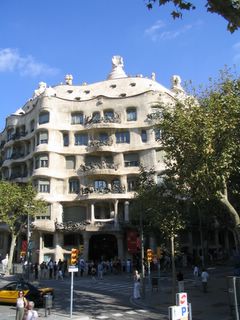
Barcelona - La Pedrera
Growing up in Austria, I made a few trips to Italy during my early
years, mostly to places like Venice, Udine and Trieste. In the late
80s I camped my way through the Ligurian Coast and saw places like
Genoa, Imperia, San Remo, Lago di Garda and Lago di Iseo, but that
was a long time ago. In 1995 I spent some time in Milan, Turin (Torino)
and Lugano. And more recently, during my November 2004 trip to Austria
I went on a one-day exploration of Cividale in Northern Italy.
Italy, particularly the south, is on my to-do list, since I haven't
really had a chance yet to explore this country in any big way.
But believe me, I've seen a great number of travel shows about Italy.
Just recently I caught a wonderful show on the Spanish-Italian TV
channel in Toronto (Telelatino) that featured helicopter shots of
the south of Italy - Naples, the Amalfi coastline, Capri, Calabria,
etc. Breathtaking, that's the only way to describe it.
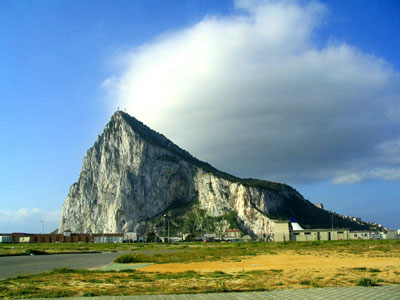
Gibraltar - a British outpost on Spanish territory
So when a travel addict like me needs to get a fix, I check out
different venues to see if there are any travel presentations going
on where I might be able to satisfy my virtual travel cravings.
So this past Thursday I went to the G.A.P
Store in Toronto's Annex neighbourhood to attend a travel presentation
about Spain and Italy to get me started on my far-away dreams. The
G.A.P Store is great since it features a whole bunch of useful and
educational seminars - just recently I got educated on how
to select the right travel gear, and a few weeks ago I attended
their "Brazil Adventures"
- another place I have to go to one day....
Gerry Da Costa manages the G.A.P Store and is one of those people
who has had the chance to travel the world. He also used to live
in Spain for 3 years, so he has become a real expert on this country.
He started off by explaining the Spanish flag to the crowd, that
the two towers on the flag refer to a legend where Hercules split
the mountains and created Ceuta (a Spanish outpost on the North
African Coast) and Gibraltar (British territory on the Spanish side).
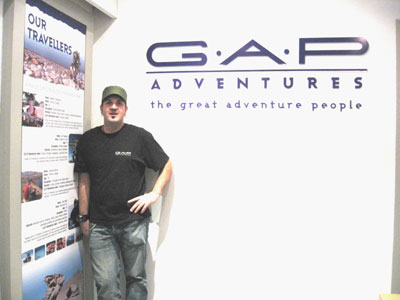
Gerry talks to us about Spain and Italy
He went on to explain that Spain consists of 17 autonomous regions,
all of which are very different. 4 major regional languages are
spoken in Spain: Castellano (standard Spanish), Catalan (in Catalonia,
the region surrounding Barcelona), Euskera (the language of the
Basque region) and Gallego, spoken in Galicia, which is strongly
influenced by Portuguese. The architecture and gastronomy in these
various areas are quite distinct, providing for a diverse travel
experience.
Next Gerry explained that G.A.P
offers a huge range of small group adventures all throughout the
world, including a variety of special tours for Spain and Italy.
The formats can vary, from pure sightseeing tours to hiking/walking
tours to more active hiking / biking& rafting tours. Accommodation
is always in locally owned hotels to make sure that the money stays
in the local economy. He showed us a few pictures of some of the
accommodations, all of them very clean, comfortable and centrally
located.
Gerry introduced us to G.A.P's Catalonia
Walking Adventure, which is an 8-day active adventure
that starts with arrival in Barcelona, where the first day is spent
exploring the unique architecture by Spain's most famous architect:
José Antonio Gaudi. Of course, Barcelona offers much more,
the famous downtown Barri Gotic, the Olympic Park, and Park Guell
(also built by Gaudi). The Sagrada Familia cathedral, Gaudi's unfinished
masterpiece, is a must see destination. Gaudi, interestingly enough,
passed away almost anonymously in 1928, after having been hit by
a street car, an unfortunate end for an eccentric genius.
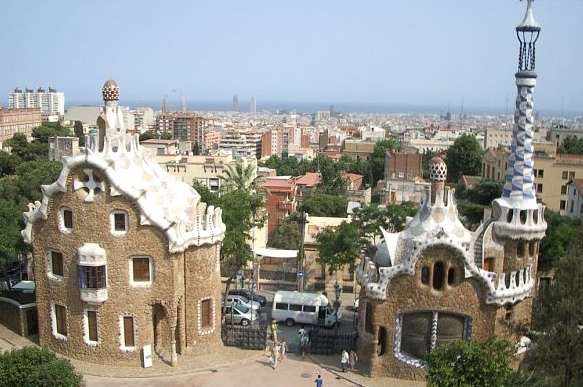
Parque Guell, by Gaudi
The tour continues to the historic town of Olot, an authentic Spanish
village with interesting museums. From there participants take the
train to the remote Vall de Nuria to spend two days hiking and relaxing,
in a location deep inside the Pyrenees close to the French border.
A train trip from Nuria via Ripoll to Barcelona is the last part
of the tour, providing another opportunity to explore the Catalonian
capital.
The next tour Gerry discussed is an 8-day active adventure called
Catalonia
by Bike. which also covers Barcelona, Olot and Ripoll.
In addition, participants cycle into Gerona on the BiciCarril (Catalonia's
famous bike trail). Gerona is an ancient walled city that dates
back to Roman times. For two centuries it was controlled by the
Moors, then it came under Jewish control for almost 6 centuries.
It was besieged 21 times and earned itself the nickname "immortal"
since it survived five attacks in the 19th century. The architectural
heritage of Gerona is astounding and dates all the way back to Roman
times.
Biking continues towards St. Feliu de Guixoles on the coast, a
typical Mediterranean town right in the heart of the Costa Brava.
The surrounding coastline features stunning cliffs, coves and bays
with fine sand beaches. Watersports, hiking and biking are all popular
pastimes in the area. The town itself offers a variety of cultural,
architectural and historic points of interest, including a monastery,
built in 1723 by the Benedictine Order. After St. Feliu the tour
concludes with a bus trip back to Barcelona.
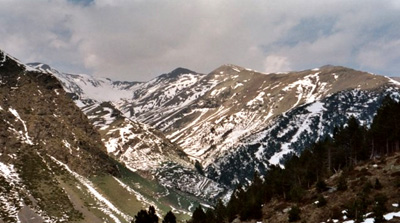
The mountain scenery near Olot
A notch up in activity level is the 15-day active adventure called
Spain
Hike, Bike & Raft. As with the other two Catalonian
tours, the tour begins in Barcelona and continues by bus to Llavorsi,
a centre for outdoor activites. Options on this tour include mountain
biking, hiking, canyoning, bungee jumping, horseback riding or parachuting.
The next stop on the tour is Andorra La Vella, the capital city
of the world's smallest nation Andorra. Some free time is built
in for optional outdoor activities or for visiting a spa. Two days
are then spent in the Vall de Nuria, a favourite destination of
nature lovers. From the historic town of Olot the tour continues
to the Garrotxa National Park which is located in an impressive
volanic landscape, featuring dense oak forests, narrow and wide
valleys. The travel group has the opportunity to hike two volcanoes,
from where they get an awesome view of the local scenery. The tour
continues to the historic city of Gerona, to St. Feliu de Guixoles
and back to Barcelona.
The next Spanish adventure is called the "Great
Moorish Experience", which is a 15 day tour that
focusses on history, architecture and sightseeing. Moorish rule
over Spain lasted for more than 700 years, from 711 A.D. to 1492
A.D., when the Catholic Monarchs, Ferdinand and Isabel, finally
expelled the Moors from their last strongholds and forced the remaining
Moors to convert to Catholicism. Mudejar art is famous for its beauty
and was created by converted Moors.
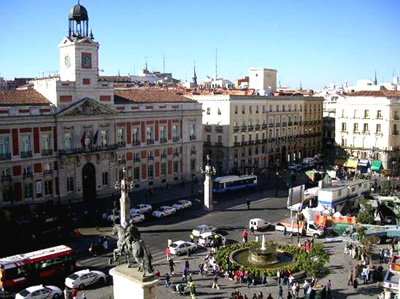
Madrid
The tour begins in Madrid, Spain's exciting capital city. On the
first day no activities are planned, which allows participants to
explore places such as the Museo del Prado or the Museo Thyssen-Bornemisza
(holding paintings from Titian to Picasso). The royal palace - the
Palacio Real, the Real Jardin Botanico and the Escorial, a magnificent
palace constructed by Felipe II, are all favourite places to explore
in Madrid. Nightlife is centered around the Plaza del Dos de Mayo.
The next two days are spent in Seville, one of the most colourful
and interesting cities in Spain. Seville is a center of Moorish
history and culture, and home to the world's largest gothic cathedral.
At 76 m of height, the adjoining tower, La Giralda, offers great
views of the city and originally was a Moorish minaret, constructed
in the late 12th century. The Christian bell tower was later added
in 1568.
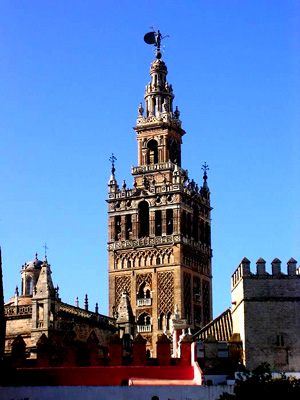
La Giralda - Seville's famous bell tower
After Seville the tour continues to the Costa de la Luz ("Coast
of Light") which offers a nice break from city sightseeing.
The coast is located on the western side of Andalucia, and the town
of Tarifa is one of the most popular spots for windsurfing. Day
trips to Gibraltar or a visit of Tangier in Morocco are popular
outings from this location. Sperm whales migrate through the Strait
of Gibraltar from April to June, and Orcas visit the area in July
and August.
Next on the agenda of the Great Moorish Experience is Ronda, which
is most well-known for its 100 m deep gorge that separates the town
into two sections. The Puente Nuevo was constructed in 1751 and
is the most photographed site in Ronda. Ronda is also known as the
birthplace of bullfighting and features one of the oldest bullfighting
rings in the country. The House of the Moorish King and the Arab
Baths are also famous sights in Ronda.
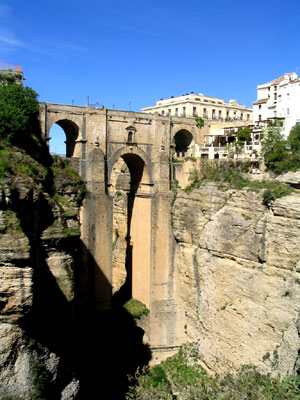
The famous Puente Nuevo of Ronda, Spain
Cordoba is the next stop on the trip: one of the centers of Moorish
culture and a place where Moors, Jews and Christians live peacefully
until the Reconquista. During the Moorish era, science, arts, architecture
and philosophy flourished. Cordoba is home to the Mezquita, the
third-largest mosque in the world, and interestingly enough, it
is not oriented towards Mecca, but rather towards Damascus. When
Cordoba was reconquered in 1236 the mosque was converted into a
Christian Cathedral. The Capilla Real (Royal Chapel) was built inside
the mosque in the 13th century and in 1523 King Charles V and the
Catholic Church decided to build a Christian cathedral inside the
original mosque, a project that took more than 230 years and introduced
Gothic, Baroque and Renaissance architecture.
Three days are then spent in Granada, one of the most important
cities of the Moorish empire. Granada is most well-known for its
great Moorish castle, the Alhambra, which is divided into three
sectiosn: the Alcazaba, the Palacio Nazaries and the Generalife.
The Alcazaba dates all the way back to the 11th century and offers
stunning views towards the city of Granada and the surrounding snow-capped
Sierra Nevada mountains. The Palacio Nazaries features the famous
Patio de los Leones and the Generalife was the summer palace of
the sultans.
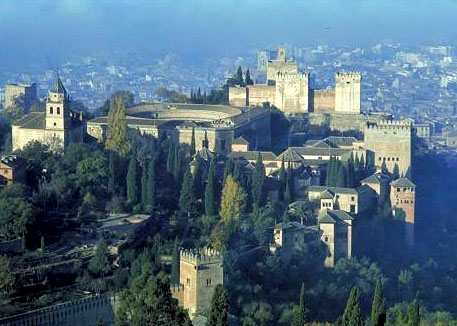
The famous Alhambra Moorish Castle in Granada
One day is spent in Valencia, after Madrid and Barcelona the third-largest
city in Spain. This is where the most Spanish of foods had its origin:
paella. Valencia is surrounded by fertile plains that are at the
heart of Spain's agriculture. Two days are allocated towards exploring
Barcelona before the tour heads back to Madrid.
Gerry then introduced us to G.A.P's fifth tour in Spain: it is
a 15-day active adventure called "The
Pilgrim's Way" which follows
the ancient pilgrimage route of the Camino de Santiago for 260 km
from Leon to Santiago de Compostela. The tour begins in Leon, a
city that dates back to 68 AD when a Roman Legion was headquartered
here to fight back the advancing Cantabrian and Asturian highlanders.
Leon is located in a fertile plain and today has a population of
more than 120,000. The Cathedral, the Collegiate Church of San Isidoro
and the Convent of San Marcos are major sights in Leon.
The first 4 walking days cover Astorga, Rabanal del Camino, Ponferrada,
and Villafranca del Bierzo. Rabanal del Camino features massive
stone houses and used to be a bastion of the Ponferrada Templars
who protected those travelling to Bierzo. After a 30 km trek the
next day, pilgrims reach the village of Ponferrada, which, at roughly
60,000 inhabitants, is the last great city before arriving in Santiago
de Compostela. Villafranca del Bierzo originally was a stop for
travelling merchants and by the 12th century half the population
consisted of foreigners. Villafranca del Bierzo features the Santiago
cathedral as well as a Roman temple with a beautiful doorway and
facade.
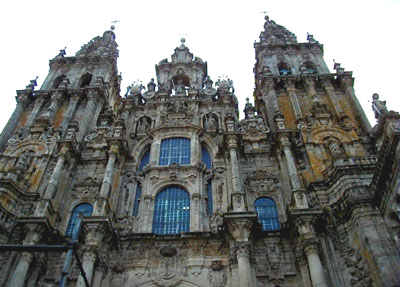
The cathedral in Santiago de Compostela
The pilgrim's way continues to the famous mountain pass O Cebreiro
where you enter Galician territory. The scenery includes temples
and picturesque rural villages. From here two days are spent trekking
to Sarria along mountain trails at an altitude between 800 and 1300
m. Sarria is a small mediaval town with a population of about 12,000
people. It features the cathedral of Santa Marina and a beautiful
old section of the city.
Days 9 to 11 are spent hiking from Sarria via Portomarin to Palas
de Rey. Portomarin is located on the shores of the Miño River
and its population is roughly 12,000. One of the most important
sights is the cathedral / fortress San Nicolas, which was constructed
in the 12th century. Palas de Rey has about 5000 inhabitants and
used to be a meeting point for pilgrims to regroup prior to starting
the last leg of the trip to Santiago de Compostela. The church of
San Tirso and the castles of Pambre and Felpos are the main sights
in this town.
The next 3 days are spent trekking from Arzua to the final destination:
Santiago de Compostela. Arzua features the ruins of the old Convent
of Magdalena, constructed in the 14th century, historically used
as accommodation for poor pilgrims traveling towards Santiago de
Compostela. The final destination on this pilgrimage, Santiago de
Compostela, has attracted pilgrims from all over the world for many
centuries. The official end point of the pilgrimage is the stunning
cathedral on the magnificent Praza do Obradoiro. This is where St.
James the Apostle is supposed to be buried. A city tour is included
and introduces the travellers to the historical and religious significance
of this city of 90,000 people.
After introducing us to G.A.P's Spanish tours, Gerry presented
to us their two Italian tours, starting with the "Amalfi
Coast" tour, an 8-day active adventure. The Costa
Amalfitana is one of the most scenic stretches of coastline anywhere
on this planet and this trip starts out with an arrival in Agerolo.
The entire travel group stays at the Agriturismo Sant Alfonso, a
former monastery dating back to the 16th century. The monastery
features beautiful gardens, terraces and staircases that lead you
out into lemon tree groves and grape vines. Dining is al fresco,
overlooking the Mediterranean Sea.
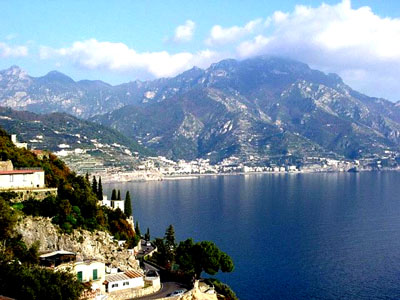
The stunning Amalfi coastline
The town of Ravello, made famous by Wagner, is next on the menu.
Travellers can visit the many galleries and churches, or simply
relax in an outdoor cafe on the main square. The next day a bus
tour whisks the travellers to Punta Campanella, the starting point
of a walking route that hugs the coastline and offers stunning views
of the sea, the local villages and the island of Capri. Day 4 is
spent exploring the famous ruins of Pompeii, victim of a volanic
explosion in 79 A.D. A guided tour provides further background information
about this unique location and after that travellers are able to
explore the site on their own.
Day 5 is dedicated to the "Walk of the Gods", probably
the most famous walk in the region. The trail climbs high above
the coastal towns of Positano and Praiano. These ancient trails
were once the only road connecting these two villages. The next
day is dedicated to exploring the Grotto Di’smeraldo, a maritime
cave of unbelievable colour. Afterwards some time is allocated for
shopping in Amalfi. Day 7 is a free day which allows visitors to
explore the gorgeous islands of Capri or Ischia. Alternatively you
can rent a scooter and embark on your own discoveries. Departure
is on day 8 from Agerola.
The last trip that Gerry introduced to us is called "Italy
Hike, Bike and Raft" and it is a 15 day active
adventure trip. The trip starts in Florence where the arrival day
is allocated towards individual explorations. Florence, the capital
of Tuscany, was founded in the first century B.C. and is the birthplace
of the Italian language and the Italian Renaissance. Culture lovers
delight in visiting the famous Duomo, the Uffizi Gallery, the Medici
Chapels, the medieval Ponte Vecchio or many of the other sights
Florence has to offer. There is just so much to see and do in Florence.
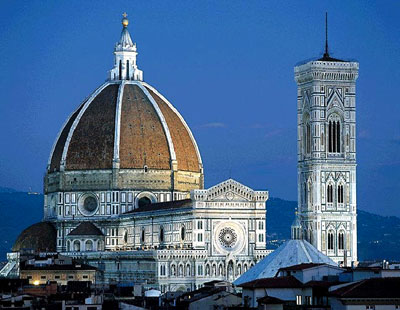
Florence's famous Duomo
Days 2 to 4 are spent in the picturesque small Tuscan town of Lucca.
From here a train excursion takes the visitors to the spectacular
Cinque Terre area in Liguria where one day will be spent hiking.
Lucca is a well-known classic medieval city that is surrounded by
Renaissance walls. Its silk trade and olive production made it one
of the most prosperous cities in Tuscany. Vineyards surround the
area and the relatively unknown area of the valley of Sericho is
just north of Lucca, offering fabulous hiking opportunities.
The next 3 days are spent visiting Pisa, home of the famous Leaning
Tower. This is followed by a bike tour through picturesque vineyards
and olive groves. Activitities on the second day are optional and
hiking and biking are available. The evening is spent tasting a
delicious home-cooked meal. Massa Maritima is a medieval mining
town, located at the top of a 380 m mountain. The Old City (Citta
Vecchia) features Romanesque architecture and the Piazza Garibaldi
and the Duomo, dating to the 13th century are the main attractions.
This is a favourite destination for biking or hiking enthusiasts.
Days 8 to 10 are spent in and around Cortona, a medieval hill town
with winding streets, wine shops and boutiques. On the second day
a bike tour visits a vineyard, and on day 10 the day is free with
optional activities such a a visit to the historic city of Siena
or some more hiking and biking. Ortona itself is perched on a mountain
and has many precipitous staircases, offering magnificent views
towards the Lago Trasimeno.
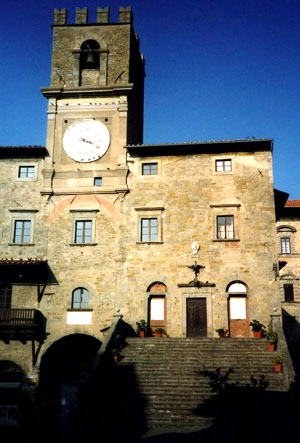
Historic Cortona
The next 3 days are spent close to Norcia and include Italy's best
white water rafting adventure on the River Nera. Norcia is located
in a remote Umbrian valley and features a heavy defensive wall.
The Piazza San Benedetto is at the heart of the city which is also
the birthplace of Saint Benedict, the founder of the Benedictine
order and the first Christian monk. The entire region is a culinary
centre and known for its delicacies: salami, cold cuts, truffles,
fresh river trout and fine chocolates. On day 12 there is an organized
hike and the group is able to determine its length.
On day 14 a train whisks the travellers to Rome, the Eternal City.
Everyone has a chance to see the city and its historic sights, to
savour its famous cuisine and to partake of its nightlife. Departure
takes place on Day 15 from Rome.
As I said, Spain and Italy remain among my favourite destinations,
and who knows, maybe a small
group adventure tour will be the way to explore them on one
of my next trips. It is certainly a great choice for people who
enjoy not having to organize every little detail by themselves and
who like to travel safely with a comprehensive, diverse itinerary
for 8 to 15 days.
Related Articles:
More advice from the G.A.P store: how to select the proper
travel gear
A presentation on "Brazil Adventures"
at the G.A.P Store
G.A.P Adventures
is Canada's largest adventure travel company and a leader in socially
and environmentally sensitive travel. G.A.P is also the sponsor
of the grand prize for our first story contest: an exciting adventure
cruise on the Amazon on the historic and unique Explorer expedition
cruise ship. Visit our contest page to find out more about our
first travel story contest.
|